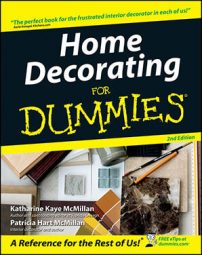Ceilings are often overlooked when people are thinking about interior decorating. But all sorts of techniques — from raising and lowering your ceiling to adding beams or creating coffers — can change the look of your room.
Constructing a false ceiling: Take the idea of a dropped or lowered ceiling to new heights by asking a carpenter to drop (lower) only the outside perimeter of a too-high ceiling. Then have the carpenter install a light in the center area and cover it with a stained glass (real or faux) or other translucent cover. (An alternative may be to install a prefabricated plastic dome that looks like stained glass. Ask your local lighting dealer for sources.)
Raising the ceiling: Liberate your room. Ripping out a too-low ceiling to the rafters creates a dramatic effect and expands the space. Raising a ceiling is definitely a job for professional carpenters or highly skilled do-it-yourselfers.
Including classical touches: Traditional interiors used fancy, carved plaster trims on ceilings, especially on ceiling areas above chandeliers. Many people now have a renewed interest in these ceiling-enhancing decorations. They’re available in a lightweight, easy-to-install plastic that looks like the real thing. Ask to see them at your local home center or building supply store.
Adding beams: Beams add line, direction, and pattern to ceilings. Different kinds of beams are used traditionally in various styles of architecture. Heavy rough beams are characteristic of rustic Colonial American and certain Old World European interiors. Lighter, more refined box beams show up in fancier Early American homes. In other interiors, beams are whitewashed, bleached, antiqued, or stenciled.
Painting the space between beams a light color and the beam itself a darker contrasting color heightens the illusion of depth. This trick is a neat space expander in a small- or medium-sized room. Another decorating trick is to paint a low ceiling and beams in a pale color. This trick tends to raise them both, making the ceiling seem higher.
Creating coffers: A coffer is a variation on a beamed ceiling. One difference is that, in beamed ceilings, beams run in one direction, creating repeating lines. When using coffers, you use fewer beams or beam-like architectural elements that cross at right angles, creating squares of empty space. Looking up at a coffered ceiling is like looking into the insides of many boxes. Take coffering one step further by decoratively painting or stenciling the wells (areas inside the coffers or beam-like structures).
Using planks: Planks — especially redwood and teak — add texture, rich color, and a subtle line to ceilings. If you use real-wood planks in a bathroom, make sure the room is well ventilated and ask your paint dealer about the best coating to protect the wood from moisture. Because planks create lines, make sure they run in the direction you want the eye to travel. Applied lengthwise in a rectangular room, planks make the room look even longer. To make the room seem wider and shorter, apply the planks crosswise. If you’re handy, you can install the planks yourself. If not, contract a carpenter.

